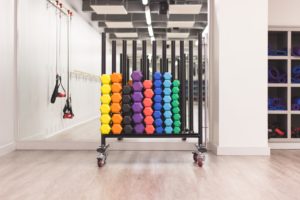One of the top reasons people start exercising is to lose weight. However, there are several fitness myths when it comes to working out for weight loss.
Fitness Myth #1: Spot TrainingHave you tried doing crunches, sit ups, ab rollers and leg lifts only to find yourself with the same abdominal fat only now you are so sore you avoid laughing, coughing, and bending over for a few days? Well, fortunately there actually is a better way, and that is to forget about of spot training. Spot Training, one of the most popular fitness myths, refers to the idea that exercising one body part will burn fat from that body part and not others. Body fat is used for energy from your whole body no matter which muscle group you are using making abdominal crunches relatively ineffective at reducing the size of your belly fat. Solution: Larger muscles like your legs, glutes, and arms burn more calories, and have greater potential for metabolism building growth than your abs do. Knock out a full body workout to maximize the fat you burn, and enjoy a leaner overall look while you do it. Legs: squats, lunges, hip lifts Upper body: pushups, shoulder presses, bicep curls, tricep kickbacks, bent over rows Fitness Myth #2: High Reps are for Toning, Low Reps are for BulkingAre you trying to do 30 or more reps with super light weights hoping to achieve long and lean muscles while avoiding that bulky look? You probably are not doing yourself any favors, and could be reducing the effectiveness of your workout. To appear lean and toned, you need to grow muscle, period. If you are not challenging your muscles with enough resistance (weight) they will not grow or tone. Solution: When strength training, shoot for around 12 repetitions per set of your exercise, if you can do many more than 12 with good form, try increasing the weight to make sure you tire out your muscles adequately, leading them to grow lean and strong. Ask a fitness professional if you have more questions about how to develop and implement a proper strength training program. Fitness Myth #3: “Fat-Burning Zone” on a TreadmillMany cardiovascular machines and gym posters may advertise the “fat burning zone”, which you may notice is slightly slower pace than you would think a good workout should be. This is because at low intensities, such as a slow walk or even while you are sitting down, your body primarily burns fat for fuel but the overall amount may be less than desired (see: sitting). Solution: Exercising at higher intensities will burn more calories overall in less time. Even though most of them will come from sugar stored in your muscles and liver, food you take in will go to replenishing those stores over making more body fat. If your goal is to lose weight, overall calorie burn is far more important, making higher intensity exercise more efficient for those who are physical capable. Remember, intensity is relative, so what may be light work for some may be quite difficult for you. Go at a pace your body allows and be careful with new workouts. Bonus: Higher intensity exercise also creates an “afterburn” effect, where you burn more calories for the next 24 hours after your workout as your body recovers. |

